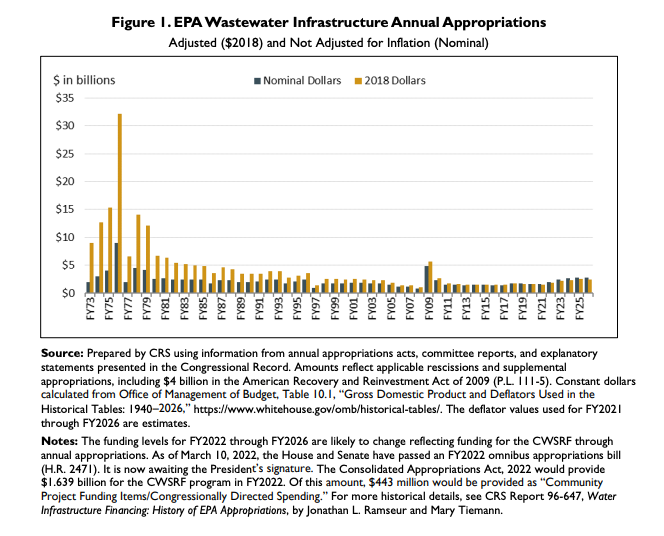The Clean Water Act At 50: How We Got Here And Where We Need To Go
Published Oct 18, 2022

Today, as the Clean Water Act turns 50, we’re looking back at how we got here and ahead toward how we can protect our water for the next 50 years.
On this day 50 years ago, Congress passed the Clean Water Act. This cornerstone environmental law of the 20th century aimed to eliminate all polluting discharges into our nation’s waterways.
For many people, the 1969 fire on Cleveland’s Cuyahoga River is the symbol of the pre-Clean Water Act era. More than a dozen fires had erupted on that one river. Many more rivers in cities from Buffalo to Detroit caught fire from industrial oil slicks and pollution.
And while the Clean Water Act has been instrumental in cleaning up these waterways and waterways across the country, much more work is necessary.
The Clean Water Act Brings A New Era of Federal Water Regulation
Historically, the federal government took a hands-off approach to water quality regulation. Restrictions on water pollution were left mostly to states and localities under a patchwork of weak regulatory regimes.
That began to change in 1948, when Congress passed the Federal Water Pollution Control Act. However, this first national framework for water quality regulation, fell flat because it failed to provide adequate federal oversight.
The Clean Water Act of 1972 was a complete revision of that decades-old law. It had two major parts:
- federal funding for publicly owned wastewater treatment plants, and
- regulations to stop pollution discharges into waterways.
The Clean Water Act emerged following an era of social change and activism amid the anti-war movement, the Civil Rights Movement, the women’s movement, and a wave of environmental activism. Responding to popular pressure, on October 18, 1972, Congress overwhelmingly voted to override a veto from President Nixon, passing the Clean Water Act into law.
Because of the Clean Water Act, the water quality of many of our nation’s rivers, lakes and wetlands has improved significantly. Wastewater systems now provide advantaged treatment for more than 16 times as many people as before the law passed. The regulations reduced most types of major water pollution, and more surface waters are now safe for fishing and swimming.
The Clean Water Act proved a clear win for public health and the environment and enjoyed widespread public support at the time. So why did President Nixon oppose it? The funding. Nixon deemed the bill’s $24 billion price tag “unconscionable.”
Clean Water Act Funding Sparks Battles For Decades
Federal funding has long been a key battleground in the fight for clean water.
The 1948 Federal Water Pollution Control Act created an unsuccessful construction loan program for wastewater treatment facilities. In 1956, after it failed to spur construction, Congress replaced that loan program with a new construction grants program. These grants were wildly popular and demand quickly outpaced available funding.
Over the following decades, Congress battled with Presidents Eisenhower and Nixon to scale up investments. In 1960, President Eisenhower, who wanted to eliminate the program, vetoed legislation passed by Congress that would nearly double the funding. He argued that water pollution was a “uniquely local blight” that shouldn’t be the responsibility of the federal government.
That November proved what we’ve learned since — elections matter for clean water. When John F. Kennedy became president, he signaled a renewed federal commitment to clean water. In his first year of office, he signed into law amendments to expand federal oversight and double the construction grants program. Kennedy recognized water quality as “a serious National problem requiring a strong National program.”
The size of the construction grants program continued to grow in the years leading up to the Clean Water Act, which authorized a substantial increase in funding (about $175 billion in today’s dollars). Then, in 1977, President Jimmy Carter signed amendments that committed to further long-term funding for public sewage systems.
From 1972 to 1984, the federal government provided nearly $41 billion in funding for wastewater infrastructure. It was the largest nonmilitary public works program since the Interstate Highway System.

President Reagan Ended the Clean Water Act’s Construction Grants Program
In the 1980s, President Reagan began targeting the construction grants program, seeking to eliminate it by 1990. His administration claimed that the program had accomplished its goal and that most remaining projects were insignificant because they were largely in small and rural areas.
Congress responded to Reagan’s pressure with the Water Quality Act of 1987, which authorized a final $18 billion over 9 years to the grants program and to the newly established Clean Water State Revolving Fund, which replaced those grants. Despite winning his sought-for phase-out, Reagan vetoed the legislation, lambasting the additional funding as “loaded with waste and larded with pork.”
But Congress once again voted overwhelmingly to override the veto. The construction grants program was phased out in 1990. Today, the Clean Water State Revolving Fund program provides low-interest loans to build and improve wastewater systems.
The Path Forward, From The Clean Water Act to The WATER Act
From the start, federal funding has been a major political fault line in the fight for clean water. It is all too often on the chopping block during federal spending battles between Congress and the Presidential administrations.
That’s why Food & Water Watch, since our founding, has been fighting for a national trust fund to provide dedicated support for safe and clean water.
Since peaking in 1977, federal funding for water infrastructure has plummeted 77% in real terms, or 84% on a per capita basis. But the EPA estimates our water infrastructure needs at least $744 billion in investment over the next 20 years, or more than $35 billion a year.
We know the costs of inaction. We see it every day as our aging infrastructure breaks downs and fails. Climate change-fueled storms overload these faltering systems, and billions of gallons of sewage continue to spill into waterways every year.
The WATER Act is the only comprehensive approach to fund improvements to our drinking water and wastewater systems. It will create the much-needed trust fund, providing $35 billion in annual funding to update and repair our water infrastructure. And it will help achieve the vision of clean water in every community.
Tell your congress members to cosponsor the WATER Act today!
Enjoyed this article?
Sign up for updates.
TO TOP


